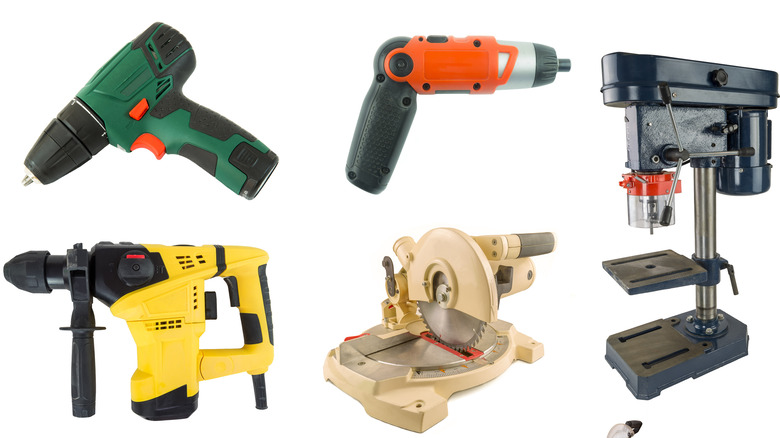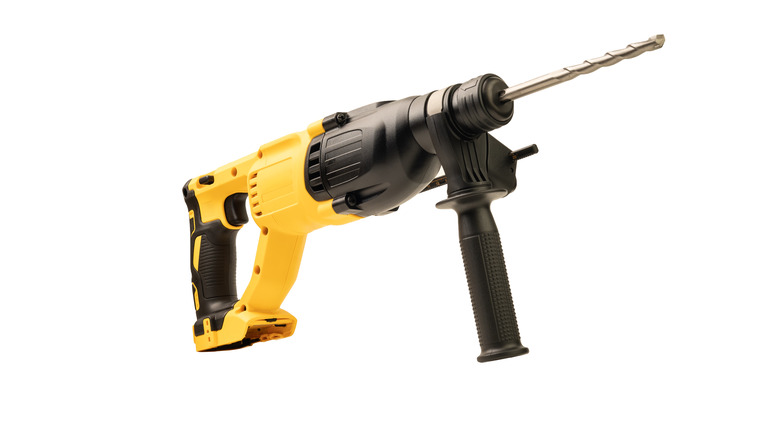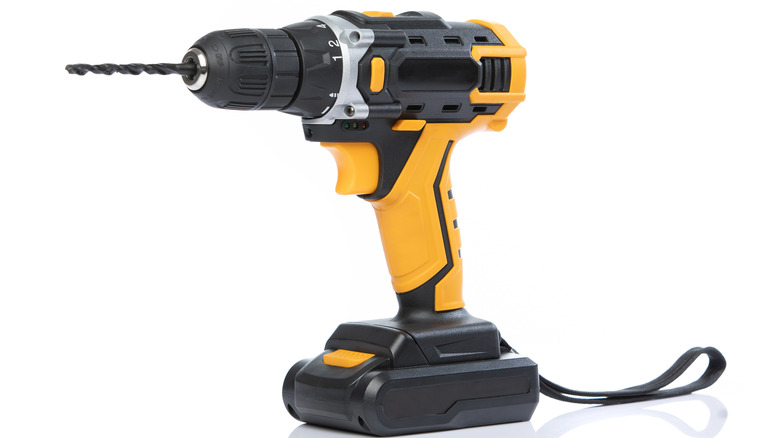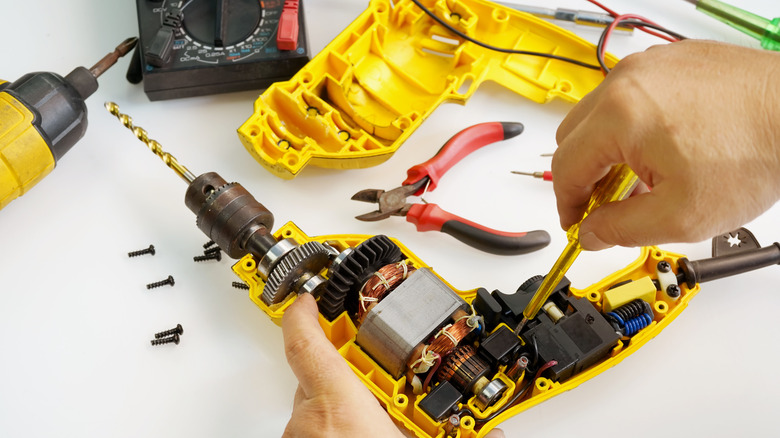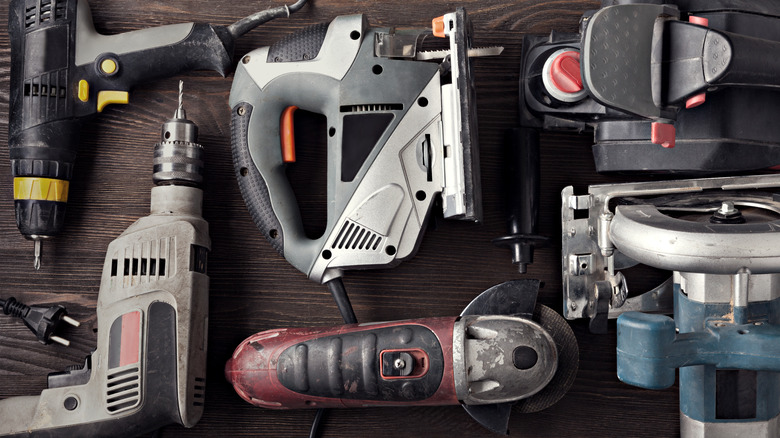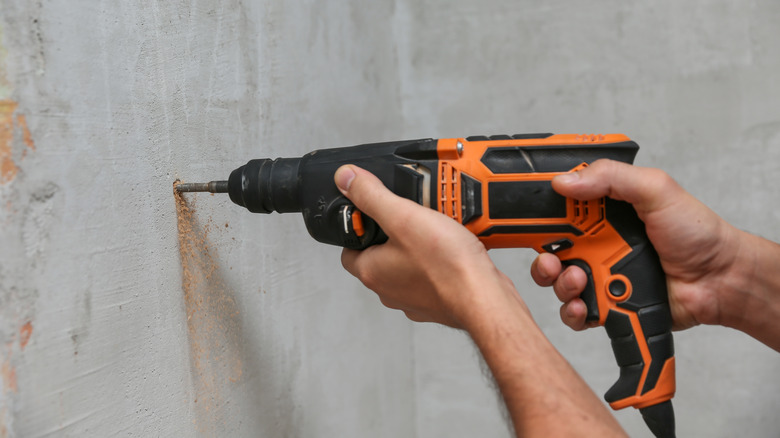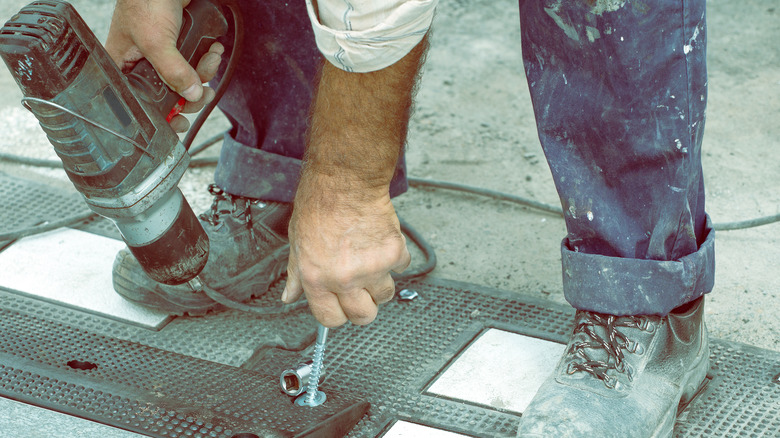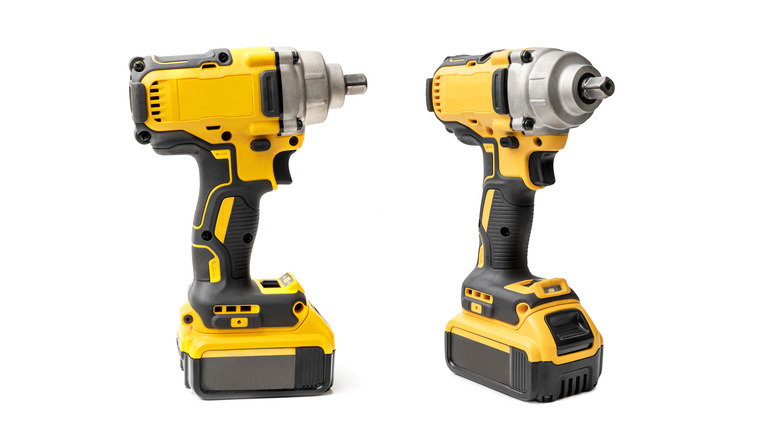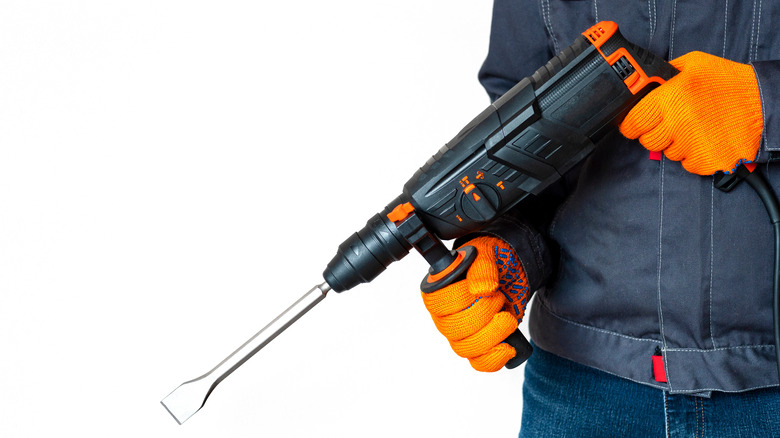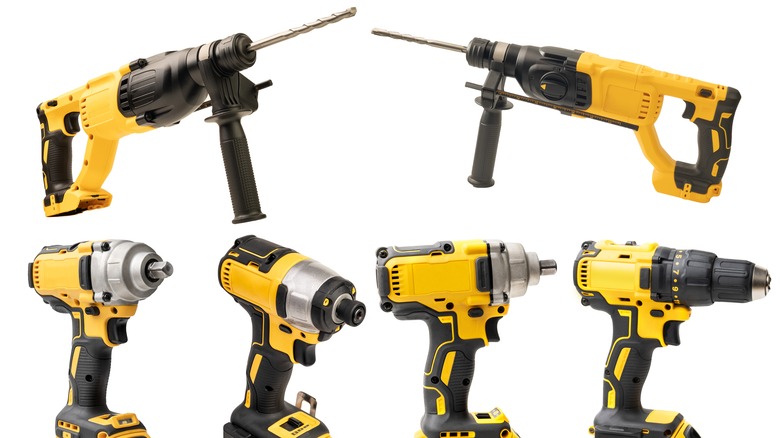The Difference Between A Hammer Drill And An Impact Driver Explained
After sharing with you the 15 tips for drilling the perfect pilot hole, we decided to guide you further on drilling as you go about your DIY projects. Believe it or not, drilling holes into any kind of material is not as hard as y'all might have experienced. You just need to use the right tool. So today, we're discussing the impact driver and the hammer drill. While these tools may look similar, Bob Vila explains that each has subtle differences geared to execute unique jobs.
According to How Stuff Works, "a hammer drill exerts a greater force directly into the bit as it hits the material being drilled, while an impact driver increases the force delivered perpendicular to the bit." These differences in machinery operation and output are what determine which tool is best for certain jobs. Let's look at when (and when not) to use a hammer drill or an impact driver.
What is a hammer drill?
Understanding the operation principles of a hammer drill leads to easier and safer applications of the machine. According to Bob Vila, the hammer drill is — you guessed it — a hammer and a drill working in tandem. Its machinery operates as a two-in-one output device: As the drill rotates, a gear-driven cam creates a continuous striking motion along the drill bit's path. Think of it as chiseling the hard material in a much faster way.
The hammer drill is a staple of a handyman's kit. It is especially useful in drilling cinder blocks, concrete, bricks, and other hard masonry materials. Contrary to drilling through these materials with basic drilling systems, which would require an anchor, a hammer drill saves you money, time, and stress because you use a Tapcon masonry screw, writes Concrete Fasteners. Drill, slam, drill, slam ... works just like magic to get the job done.
What is an impact driver?
An impact driver is a lot like a hammer drill, but there are some distinct differences between the two. The first difference is that an impact driver employs rotational energy — also known as torque — unlike a hammer drill. As Bob Vila explains of the rotational machinery of the impact driver: "It is compressed every half turn then releases, delivering tremendous force."
Explaining how it works in simpler language, the impact driver has a heavy-duty spring that is activated, twisted, and then released onto the intended drill, screw, or object in what is known as chuck rotation. The primary use of impact drivers is to drive in screws and other fasteners or to undo the same from where they had previously been (via Home Depot).
With an impact driver, you may not necessarily need to drill a pilot hole before working. However, according to WWMM, drilling a pilot hole first makes for much neater work and reduces the risk of your hardwood splitting.
How a hammer drill and an impact driver differ internally
Okay, so many of you may walk into a tool store and notice very little difference between the hammer drill and the impact driver, are we right? Well, the major difference is in the internal composition.
Diffen explains that the hammer drill has a drill that pushes forward and that drill is aided by a gear-driven cam that produces the force applied on the object. As the drill rotates, the cam creates a continuous striking motion along the path of the drill bit. This unique architecture makes a hammer drill perfect for masonry. On the other hand, an impact driver's machinery uses rotational energy via a heavy-duty internal spring to work sideways for the doing and undoing of bolts and screws.
Hammer drills and impact drivers also differ in terms of weight. While the machinery in a hammer drill is much heavier — let's say a little bit over 4 pounds and never over 8 pounds — an impact driver (which has less machinery) weighs less, about 2.6 pounds, says Cordless Drill Zone.
Do a hammer drill and an impact driver differ in appearance?
Yes, hammer drills and impact drivers differ slightly in appearance and can be easily distinguished by experts, but if you're a new DIYer, it can be much more difficult. If you're buying new tools, understanding the physical differences — which are highlighted below — ensures that you'll return home with the best tool for your project.
To start with, Tool Logic explains that hammer drills are generally for heavy duty tasks, thus heavier and larger. A hammer drill also has a prolonged barrel and a three-jaw chuck which is the drill's foremost area, and this is also the part that holds the bits.
Tool Logic also notes that impact drivers are shorter and stockier than hammer drills. In contrast to the hammer drill's prolonged barrel, the impact driver is usually stumpy, especially close to the barrel.
What are the differences in cost?
The price listing for an impact tool driver and a hammer drill is, of course, largely dependent on the store you choose to purchase your tool, the brand or model you opt for, and the capacity of the machine. However, we have narrowed the pricing down to the average costs. As noted on a listing by The Tool Square, the standard pricing for a bare tool (e.g. without batteries) impact driver is $219 and the pricing for a hammer drill is $199. So if you are on a budget, the hammer drill may be the way to go.
However, as found on the listing, if you are all for getting a deal, you should consider purchasing a kit that includes both the impact driver and hammer drill (as well as extra batteries) for $329. And did we mentioned the fact that you will save $11 on this deal?
Pros and cons of a hammer drill
The hammer drill is a very lightweight tool and battery operated, making it portable and easy to use for DIY projects. Contrary to what you may think, the fact that it is lightweight does not diminish its strength, though. It can still drill into masonry materials rather effectively, says House Grail. Yet another advantage of this tool is its affordability; coming at only $199, it's a relatively low-cost purchase for in-house repairs and small jobs.
Now, a hammer drill is not without its cons. The major insufficiency of a hammer drill is that it might not provide enough punch to get the screw in deep enough, and it also does not absorb as much shock as the rotary hammer does. This means that a hammer drill cannot cater to your intense drilling needs.
Pros and cons of an impact driver
Impact drivers are rather nice, but they do have their limitations as well as specialization. Topping the list of advantages would be the fact that they were compactly designed. The impact driver, according to Wonkee Donkee Tools, being smaller and lighter, can squeeze into all of the small and awkward spaces. Also, due to the hammer and anvil mechanism inside the tool which delivers a series of quick and powerful blows to the side of the screwdriver bit as it inserts screws, the impact driver can deliver a whopping 150 to 180 Nm, according to Tool Guyd. Therefore, it is the best choice for industrial jobs.
On the downside, Fine Power Tools noted, an impact driver does not have torque control. In layperson's language, you cannot control the amount of rotational energy that it delivers to the selected object at a given time. Also, since you may need additional tools, we think that the pricing is a little too on the high side for a product that may require you to purchase additional bits.
Durability and maintenance of an impact driver
The Home Depot offers a five-year warranty on many impact drivers, but if you maintain your tool, then it can remain functional for many more years. There are a few basic maintenance guidelines that can help your impact driver last much longer than five years.
First off, never leave your cordless impact driver at the mercy of the elements. Don't leave it outside and, after use, wipe off dust, grease, oil, and any other contaminants. Then store the tool (which likely came with a case) indoors in a dry area that's free from dust and moisture, writes Wonkee Donkee Tools. It's also important never to attempt to use the impact driver if you suspect that any part of the tool is damaged, as that can make the situation much worse. Finally, keep the instruction manual handy and always refer to it if you ever encounter problems. Sometimes just a quick glance at the guide will solve your problem.
Durability and maintenance of a hammer drill
Most hammer drills, like DeWalt drills, have a three-year warranty, However, your purchased tool will only last that long, or even longer if you learn the art of proper maintenance — and we have your back. According to SlideShare, all required repairs must be done by an experienced professional, although minor repairs may be handled by an operator with enough knowledge.
Anyway, resources available on SlideShare recommend that you should always check for oil leaks in the hammer drill and whenever the hammer drill is not in use for prolonged periods, make it a habit to tilt your tool to ensure oil flow to all parts of the machine. Also, check for cracks in the cord, tighten the bolts around the housing, and dust regularly as basic weekly and before use maintenance.
When to choose each item
The hammer drill and the impact driver are two separate tools designed for two separate purposes. Thus, in the use of either machine, functionality does not in any way overlap. You'll see what we mean shortly.
According to Bob Vila, a hammer drill can drill holes and drive screws (call it a drill-driver), but it's also specially engineered to perform one other task: bore holes through concrete, brick, stone, and other masonry materials with astonishing speed and ease; this is its distinctive factor. If you want to drill holes or install screws through masonry materials without the need for drywall anchors, you should choose a hammer drill.
On the other hand, if all you need to do is to install or uninstall bolts and screws, the machinery of an impact driver is good for this. According to The Spruce, an impact driver is especially good for uses like driving 3-inch screws into wood, a task that is difficult for a drill even with pre-drilling. So if you want to get rid of the pilot holes, or can not drill them, this is your go-to tool.
DIY Preferences: hammer drill vs. impact driver
This last slide is dedicated to all the ardent DIYers out there (yes, we see you.) In comparing the DIY preference of the hammer drill and the impact driver, it's only fair to find a middle ground. That would be the fact that they can both drive screws home. There's also the fact that the hammer drill cannot make a screw come undone and the impact driver cannot work well with masonry materials.
However, if you are to get just one tool for your DIY purposes, we recommend a hammer drill because it is not limited like the impact driver in terms of materials. According to the Woodworkers Guild of America, an impact driver is designed for woodworking, and we are looking for something encompassing. So, we recommend a hammer drill because not only can this cut into the wood, it can also drill through masonry material, says Tools Today.
